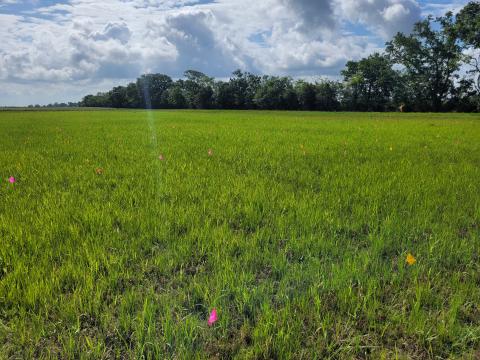Dr. Caitlin deNux publishes on the evaluation of organic and synthetic herbicide applications on weed suppression in Louisiana
Wed, 04/17/2024 - 8:17am
A weed is defined as any plant that is considered undesirable in a particular location and can typically be classified as either a grass, sedge, or broadleaf weed species. The presence and competition of weed populations in agricultural fields can negatively impact crops by lowering the value of harvested plants, reducing proteins in grains, and decreasing fruit or seed size in desired produce. Before the introduction of herbicides, most weed control methods were mechanical or used cultural practices. Modern agriculture uses a variety of synthetic herbicides with varying modes of action to control weed populations. Today, herbicide expenditures account for two-third of all pesticides used in US agriculture as growers try to control weeds in their operations. However, the overuse of synthetic herbicide applications has the potential to produce chemical run-off, changes in soil health and soil health conditions, and create herbicide-resistant weeds. These outcomes have encouraged growers to seek alternative methods for their weed management programs. Organic pesticides have helped address some of these challenges related to sustainability and environmental health. However, organic herbicides are not typically assessed in conventional cropping systems as they are seen as inferior in weed suppression when compared to their synthetic counterparts.
n this study, a two-year non-irrigated experiment was conducted from 2020 to 2022. The experimental design was a randomized complete block (RCB) design with each plot/treatment area approximately 0.00056 ha−1 in size. Four organic (a DIY formulation, Vinegar Weed & Grass Killer, Avenger Weed Concentrate, and Scythe) and four synthetic herbicides were assessed on their performance on local weed species on two different soil types; Midland silty clay loam and Acadiana silt loam. Herbicide application rates were applied at label recommended rates using a CO2 backpack sprayer and a three-tip hand wand. Weed biomass was collected prior to initial herbicide applications. A plot suppression rating (0-100; zero indicating no control and 100 indicating complete weed destruction) and weed surveys per weed species (0-10; zero indicating no control and 10 indicating complete weed destruction) were conducted at time intervals (24-hours after application, 7-days after initial application (DAT), 30 DAT, and 60 DAT) to evaluate how effective treatments were in controlling target populations over a two-month period. By the end of the two-year experiment, thirty-two weed species were evaluated. To explore the effects of herbicide applications on weed suppression, with a focus on herbicide efficacy overall and on a per-species basis, a two-way analysis of variance (ANOVA) was utilized for statistical analysis.
The results showed that organic herbicides were not comparable to synthetic herbicides in weed suppression. Weed biomass was not affected by treatments in Year 1 (p = 0.904) or Year 2 (p = 0.911), and potentially influenced herbicide efficiency. Increased biomass, particularly below ground, could have a dilution effect on herbicide efficacy and higher weed densities could make herbicides more likely to fail as overlapping leaves prevent sufficient coverage across target species. Plot suppression was not affected (p=0.314); suggesting that despite different herbicide approaches, Year 1 and Year 2 were comparable and initial herbicide applications did not significantly affect overall weed populations. Regarding weed surveys, Roundup and Rifle (synthetic herbicides) had the greatest impact on weed species across Year 1 (p less than 0.001) and Year 2 (p less than 0.001). These are systemic herbicides that work well on most species of weed, so this may explain why they had the most effect.
The organic herbicides used, despite having different modes of action, were statistically similar in performance, displaying some physical damage but most weed species recovering over time. Without the presence and competition of row crops usually associated with farming operations, the experimental fields quickly reformed back to existing conditions prior to spray applications. According to the results of this study, under specific environmental conditions, organic herbicides did not present adequate control and residual to sustain weed suppression in conventional cropping systems. It is recommended for weed management programs, using recommended application rates outlined on the herbicide label, and conducting applications with environmental stewardship in mind, could decrease possible herbicide effects within the environment.
Read the work here: https://www.mdpi.com/2071-1050/16/7/3019
